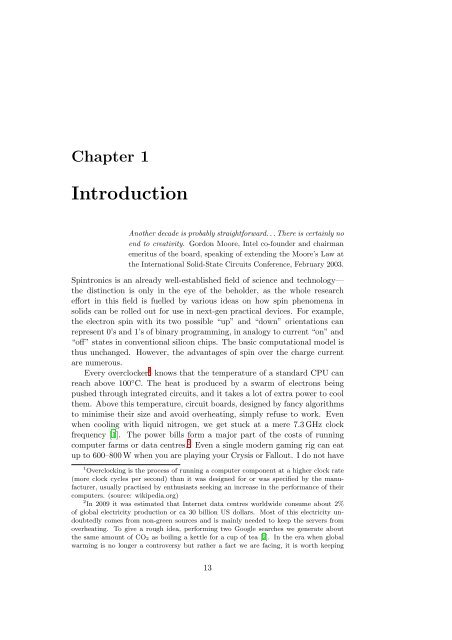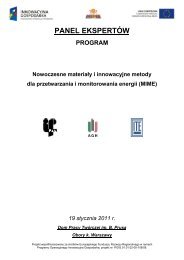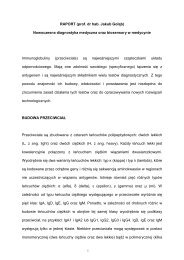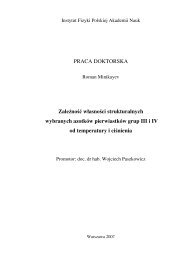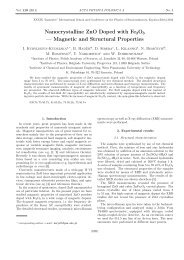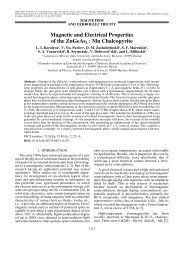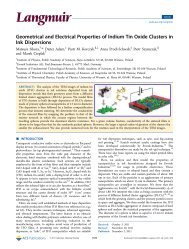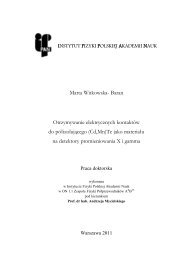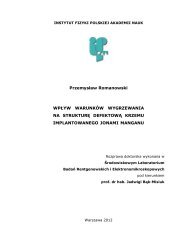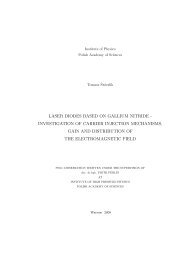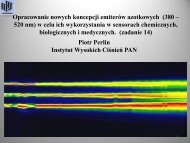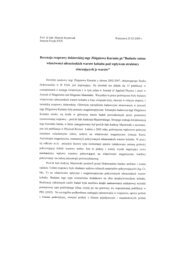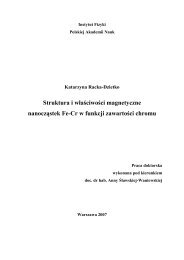Spin waves and the anomalous Hall effect in ferromagnetic (Ga,Mn)As
Spin waves and the anomalous Hall effect in ferromagnetic (Ga,Mn)As
Spin waves and the anomalous Hall effect in ferromagnetic (Ga,Mn)As
You also want an ePaper? Increase the reach of your titles
YUMPU automatically turns print PDFs into web optimized ePapers that Google loves.
Chapter 1IntroductionAno<strong>the</strong>r decade is probably straightforward...There is certa<strong>in</strong>ly noend to creativity. Gordon Moore, Intel co-founder <strong>and</strong> chairmanemeritus of <strong>the</strong> board, speak<strong>in</strong>g of extend<strong>in</strong>g <strong>the</strong> Moore’s Law at<strong>the</strong> International Solid-State Circuits Conference, February 2003.<strong>Sp<strong>in</strong></strong>tronics is an already well-established field of science <strong>and</strong> technology—<strong>the</strong> dist<strong>in</strong>ction is only <strong>in</strong> <strong>the</strong> eye of <strong>the</strong> beholder, as <strong>the</strong> whole researcheffort <strong>in</strong> this field is fuelled by various ideas on how sp<strong>in</strong> phenomena <strong>in</strong>solids can be rolled out for use <strong>in</strong> next-gen practical devices. For example,<strong>the</strong> electron sp<strong>in</strong> with its two possible “up” <strong>and</strong> “down” orientations canrepresent 0’s <strong>and</strong> 1’s of b<strong>in</strong>ary programm<strong>in</strong>g, <strong>in</strong> analogy to current “on” <strong>and</strong>“off” states <strong>in</strong> conventional silicon chips. The basic computational model isthus unchanged. However, <strong>the</strong> advantages of sp<strong>in</strong> over <strong>the</strong> charge currentare numerous.Every overclocker 1 knows that <strong>the</strong> temperature of a st<strong>and</strong>ard CPU canreach above 100 ◦ C. The heat is produced by a swarm of electrons be<strong>in</strong>gpushed through <strong>in</strong>tegrated circuits, <strong>and</strong> it takes a lot of extra power to cool<strong>the</strong>m. Above this temperature, circuit boards, designed by fancy algorithmsto m<strong>in</strong>imise <strong>the</strong>ir size <strong>and</strong> avoid overheat<strong>in</strong>g, simply refuse to work. Evenwhen cool<strong>in</strong>g with liquid nitrogen, we get stuck at a mere 7.3GHz clockfrequency [1]. The power bills form a major part of <strong>the</strong> costs of runn<strong>in</strong>gcomputer farms or data centres. 2 Even a s<strong>in</strong>gle modern gam<strong>in</strong>g rig can eatup to 600–800W when you are play<strong>in</strong>g your Crysis or Fallout. I do not have1 Overclock<strong>in</strong>g is <strong>the</strong> process of runn<strong>in</strong>g a computer component at a higher clock rate(more clock cycles per second) than it was designed for or was specified by <strong>the</strong> manufacturer,usually practised by enthusiasts seek<strong>in</strong>g an <strong>in</strong>crease <strong>in</strong> <strong>the</strong> performance of <strong>the</strong>ircomputers. (source: wikipedia.org)2 In 2009 it was estimated that Internet data centres worldwide consume about 2%of global electricity production or ca 30 billion US dollars. Most of this electricity undoubtedlycomes from non-green sources <strong>and</strong> is ma<strong>in</strong>ly needed to keep <strong>the</strong> servers fromoverheat<strong>in</strong>g. To give a rough idea, perform<strong>in</strong>g two Google searches we generate about<strong>the</strong> same amount of CO 2 as boil<strong>in</strong>g a kettle for a cup of tea [2]. In <strong>the</strong> era when globalwarm<strong>in</strong>g is no longer a controversy but ra<strong>the</strong>r a fact we are fac<strong>in</strong>g, it is worth keep<strong>in</strong>g13


